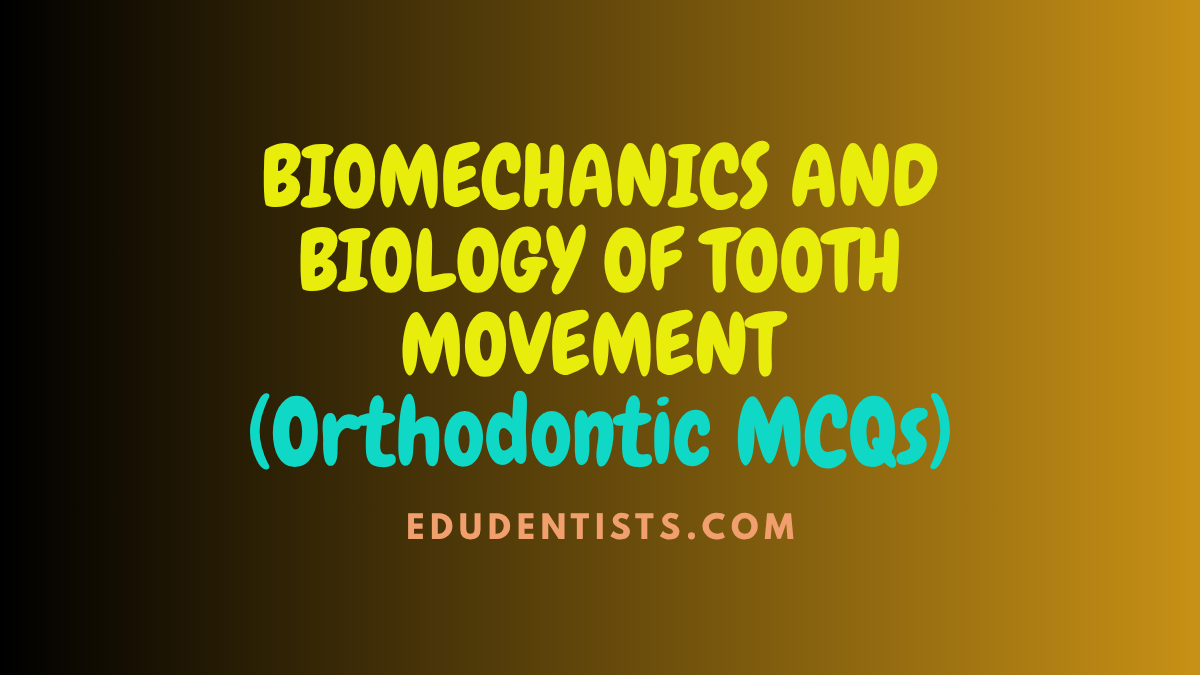
BIOMECHANICS AND BIOLOGY OF TOOTH MOVEMENT
Ortho MCQs
BIOMECHANICS AND BIOLOGY OF TOOTH MOVEMENT – Ortho MCQs
1. On comparing the orthodontic force responses between bone and cementum, the cementum resorbs:
A. Less readily
B. More readily
C. Both at same rate
D. Does not resorb
2. What type of tooth movement occurs when Mc/Mf ratio is more than 1?
A. Controlled tipping
B. Uncontrolled tipping
C. Translation
D. Torque
3. The M-D displacement of the root tips comes under:
A. First-order torque
B. Second-order torque
C. Third-order torque
D. Both A and B
4. Narrow bracket results in:
A. Increase in flexibility
B. Decrease in flexibility
C. Increases interbracket-arch span
D. Both A and C
5. During extrusion of tooth, the periodontal ligament is subjected to an:
A. Area of torsion
B. Area of shear
C. Area of tension
D. Area of compression
6. Who was the first to discuss about the root resorption of permanent teeth?
A. Bates
B. Ottolengui
C. Bein
D. Becker
7. Bone remodeling theory was proposed by:
A. Bein
B. Basset
C. Farrar
D. Burstone
8. Prostaglandin was discovered by:
A. Paul Erlich
B. Von Euler
C. Ketcham
D. Frost
9. Which of the following hormone is the primary regulator of frequency of bone remodeling?
A. Thyroxine
B. Calcitonin
C. Vitamin D
D. PTH/Parathormone
10. The bone related activity of Osteoprotegerin (OPG) is:
A. Osteoblast differentiation
B. Bone resorption
C. Prevention of bone resorption
D. Bone remodeling
11. Bone contains highest concentration of
A. Calcium phosphate
B. Calcium carbonate
C. Calcium fluoride
D. Sodium chloride
12. On applying a light orthodontic pressure, what is the minimum time taken for tooth movement to: begin?
A. Occurs immediately
B. 2 days
C. 3 days
D. 4 days
13. Life span of an osteoclastic cell is:
A. 2–7 days
B. 2–10 days
C. 10–15 days
D. 15–20 days
14. The force that declines to zero between the activations is called:
A. Continuous force
B. Interrupted force
C. Intermittent force
D. Both A and C
15. An example of two couple systems:
A. Trans-palatal arches
B. Utility arches
C. Both the above
D. Nance palatal arches
16. An example for Interrupted force is:
A. Removable appliances
B. Removable appliances
C. Orthopedic appliances
D. Both B and C
17. During the physiological response to heavy pressure against a tooth, the minimum time required to generate piezoelectric signal is
A. Less than 1 second
B. 2–3 seconds
C. 3–5 seconds
D. More than 5 seconds
18. Which of the following orthodontic forces is used to correct the effects of uncontrolled tipping?
A. Torquing force
B. Couple
C. Moment of force
D. Both B and C
19. During Torquing, the center of rotation lies at:
A. C-r lies at the apex
B. C-r lies at the infinity
C. C-r lies towards the incisal edge
D. C-r lies close to C-res
20. Amount of force (in grams) required for tipping of canines is:
A. 20–50
B. 50–75
C. 40–50
D. 70–100
21. The threshold force for orthodontic tooth movement is:
A. 1–2 g/sq.cm
B. 5–10 g/sq.cm
C. 10–15 g/sq.cm
D. 20–26 g/sq.cm
22. Duration of lag phase in tooth movement corresponding to removal of hyalinized tissue is:
A. 2 weeks
B. 4 weeks
C. 6 weeks
D. 8 weeks
23. All are horizontal trajectories of maxilla, except:
A. Hard palate
B. Orbital ridges
C. Lesser wing of sphenoid
D. Pterygoid buttress
24. Pick out the WRONG statement regarding the universal sign convention for forces:
A. Lateral forces are negative and medial forces are positive
B. Medial forces are positive and distal forces are negative
C. Anterior forces are positive and posterior forces are negative
D. Buccal forces are positive and lingual forces are negative
25. The C-res of maxilla, in transverse plane lies:
A. Between the roots of premolars
B. Through the center of maxillary sinus
C. Below the orbit
D. Lateral to lateral incisors for intrusive movements